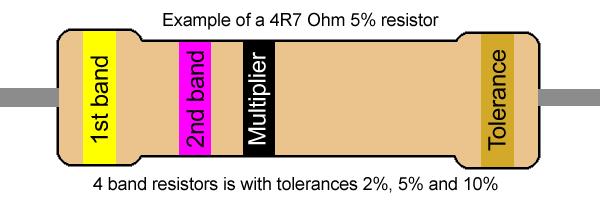Resistor color code bands explained
Resistors color codes should be read from left to right, when the grouping of the rings is to the left. If it is a 5% or 10% resistor, the gold and silver ring must be to the right. The silver and gold rings are for tolerance, and they can never be the first ring.
Resistors with 3 bands are all 20% tolerance resistors and should be decoded as a 4 band resistor.
Resistors with 6 bands are special resistors with a temperature coefficient band. These are used in equipment where the resistors ability to withstand a certain temperature, is critical.
On SMD and other small resistors, the value can be given in a numerical way, like “103F”. These numbers should be decoded in the table as a 4 band resistors.
In order to write Ohm values easily in schematics, R is used for sub 1000 Ohm values, as 0R1 = 0.1 Ohm. K is kilo and is used for thousands as in 4K7 = 4700 Ohm. M is mega and is used for millions as in 10M = 10000000 Ohm.

Resistor values table
| Color | 1st band | 2nd band | 3rd band | Multiplier | Tolerance |
| Black | 0 | 0 | 0 | 1 Ω | – |
| Brown | 1 | 1 | 1 | 10 Ω | 1% (F) |
| Red | 2 | 2 | 2 | 100 Ω | 2% (G) |
| Orange | 3 | 3 | 3 | 1 KΩ | – |
| Yellow | 4 | 4 | 4 | 10 KΩ | – |
| Green | 5 | 5 | 5 | 100 KΩ | 0.5% (D) |
| Blue | 6 | 6 | 6 | 1 MΩ | 0.25% (C) |
| Violet | 7 | 7 | 7 | 10 MΩ | 0.1% (B) |
| Grey | 8 | 8 | 8 | – | 0.05% |
| White | 9 | 9 | 9 | – | – |
| Gold | – | – | – | 0.1 Ω | 5% (J) |
| Silver | – | – | – | 0.01 Ω | 10% (K) |

It can also be a good idea to use a resistor color code calculator, to get the correct values for a band resistor. If you are designing a electronic circuit that uses transistors, you might be interested in using the transistor base resistor calculator.
Published September 24, 2013. Updated November 1, 2021.